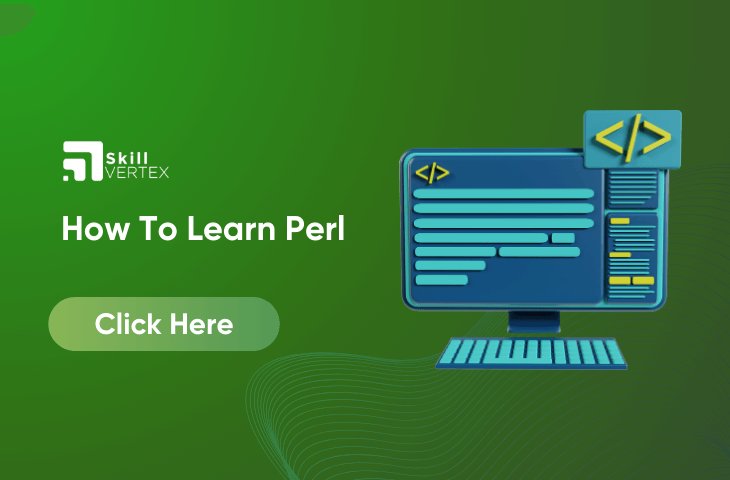Table of Contents
How To Learn Perl
If you’re curious about learning Perl, a powerful programming language, you’re in for an exciting journey. It doesn’t matter if you’re starting or have some coding experience – Perl has something for everyone. Whether you want to do simple tasks or create web apps, Perl is a useful tool. This guide will help you learn Perl step by step, giving you the skills to understand its rules, and features, and how to use it in different ways.
What is Perl
Perl is a versatile programming language that can do different things. It started mainly for managing systems and working with text. But over time, it gained more abilities like dealing with regular expressions and network connections. These days, it’s known for its skill in handling regular expressions. The first version of Perl was released on December 18, 1987, and was called Perl 1.0. There’s also Perl 6, a newer version that works quite differently from Perl 5. It’s a complete reimagining of Perl 5 and is all about using objects in programming.
What are the Features Of Perl?
Perl’s popularity and demand can be attributed to several reasons, some of which are highlighted below:
- Easy to Start: Perl is a high-level language, similar to widely used programming languages like C and C++. This similarity simplifies the learning curve for those familiar with other languages.
- Text Processing: “Practical Extraction and Reporting Language” (Perl) suggests its prowess in manipulating text. It excels at tasks like extracting information and generating reports from text files.
- Combining Best Features: Perl combines features from different languages such as C, sed, awk, and sh. This amalgamation enhances Perl’s utility and effectiveness, catering to various programming needs.
- System Administration: Perl greatly facilitates system administration tasks. It eliminates the need to depend on multiple languages by providing a single solution for various system administration duties.
- Web Integration: Perl can be seamlessly integrated into web servers to enhance processing capabilities. It also features the DBI package, simplifying the integration of web and database functions.
These attributes collectively contribute to Perl’s popularity, making it a sought-after choice for various programming tasks, from text processing to web development and system administration.
What are the Advantages of Learning Perl?
Perl stands as a reliable programming language that works well across various platforms. Although it is not an official acronym, some refer to Perl as the Practical Extraction and Report Language. It finds applications in essential projects for both government and private industries. Perl operates as Open-Source software and is licensed under the Artistic License or the GNU General Public License (GPL). It is found – Larry Wall. Perl 1.0 emerged on use-net alt. comp. source -(1987).
What are the Different Ways to Learn Perl?
1. Online Tutorials
Online tutorials provide structured lessons, often starting with the basics and gradually progressing to more advanced topics. They usually include explanations, examples, and exercises to reinforce learning. Websites offer tutorials tailored for different skill levels.
2. Interactive Coding Platforms
Many Platforms offer hands-on coding experiences. They present coding challenges and problems you can solve using Perl, helping you practice real-world scenarios.
3. Books
Books provide in-depth knowledge, often organized in a structured manner. “Learning Perl” is a popular book for beginners, and there are more advanced books for those looking to deepen their understanding.
4. Video Courses
Video courses on platforms offer visual explanations and demonstrations. Videos can help you grasp concepts more effectively and see the code in action.
5. Online Communities
Websites like Stack Overflow and Reddit have active communities of programmers who can answer your questions and provide guidance. Engaging in discussions can expose you to various perspectives and problem-solving approaches.
6. Practice Projects
Building projects is a fantastic way to apply what you learn. Start with simple projects and gradually move to more complex ones. This hands-on experience helps solidify your understanding.
7. Official Documentation
The Perl documentation is an authoritative resource provided on the official Perl website. It covers everything from basic syntax to advanced topics, making it a valuable reference as you learn and work on projects.
8. University or College Courses
Many educational institutions offer courses in programming languages, including Perl. These courses provide a structured learning environment and may include assignments, projects, and workshops with instructors.
Remember that learning a programming language like Perl is a gradual process. It’s essential to choose the methods that align with your learning style, allocate regular time for practice, and maintain a curious and explorative mindset. As you gain more experience, you’ll find that combining multiple learning approaches can provide a well-rounded and comprehensive understanding of Perl.
FAQ – How To Learn Perl For Beginners From Scratch
Q1. Is Perl better than Python?
Ans. Perl is often seen as easier to learn due to its concise syntax, but it can get complex with special characters. Python’s readability makes it a beginner-friendly choice. Python is known for its durability and versatility across different domains, while Perl’s strength lies in quick scripting and text-processing tasks. The choice between them depends on your project’s needs and familiarity with the languages.
Q2. Is Perl frontend or backend?
Ans. Perl is a backend language option for developing the server – side applications. It’s a traditional language often used for client-side application development as well.
Q3.Is Perl difficult to learn?
Ans. Perl is a user-friendly language to start learning, and it maintains its ease of learning as you progress. Its syntax is quite familiar if you’ve worked with other programming languages like C, awk, shell scripts, or even BASIC. If you have experience with any of these, you’re already on the right track to learning Perl.
Hello, I’m Hridhya Manoj. I’m passionate about technology and its ever-evolving landscape. With a deep love for writing and a curious mind, I enjoy translating complex concepts into understandable, engaging content. Let’s explore the world of tech together

